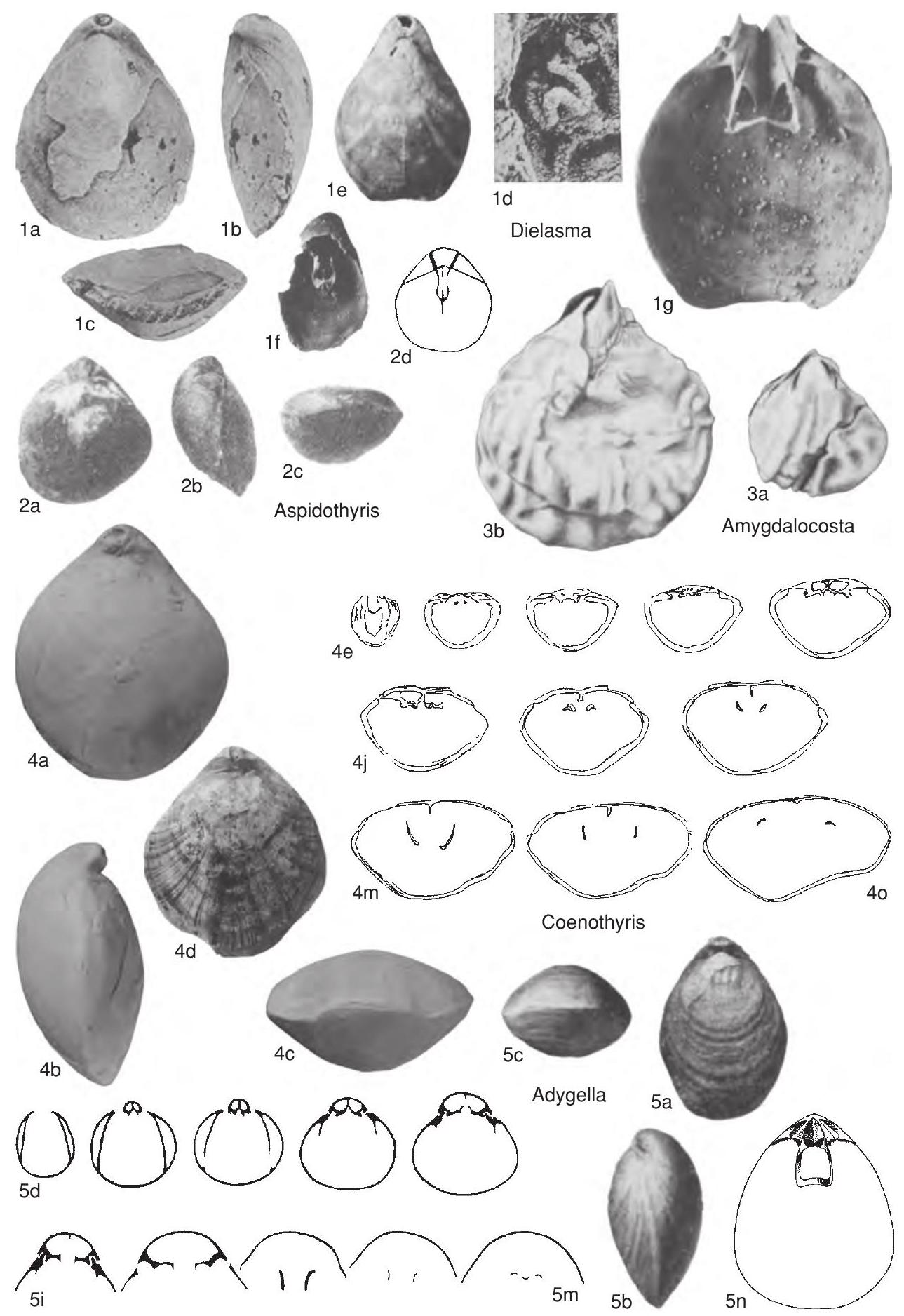Welcome to the Treatise on Invertebrate Paleontology!
Please enter a genera name to retrieve more information.

Dielasma
Classification
Phylum:
Brachiopoda
Subphylum:
Rhynchonelliformea
Class:
Rhynchonellata
Order:
Terebratulida
Suborder:
Terebratulidina
Superfamily:
Dielasmatoidea
Family:
Dielasmatidae
Subfamily:
Dielasmatinae
Formal Genus Name and Reference:
Dielasma King, 1859, p. 256, Dielasmoides WELLER, 1911, p. 443
Type Species:
Terebratulites elongatus SCHLOTHEIM, 1816, p. 27, OD
Images
(Click to enlarge in a new window)
Fig. 1342, 1 a-d .*D. elongatum (Schlotheim), upper Permian, Pössneck, Thuringia, Germany, a-c, dorsal, lateral, and anterior views of neotype, USNM 124226, X1, d, calcite encrusted loop, X1 (Stehli, 1956a).——Fig. 1342, le-g. D. zebratum Cooper & Grant, Permian, western Texas, USA, e, dorsal view of holotype, USNM 1533426, X1, f-g, juvenile and adult loops, respectively, X2 (Cooper & Grant, 1976b).
Synonyms
Dielasmoides
Geographic Distribution
cosmopolitan
Age Range
Beginning Stage in Treatise Usage:
Carboniferous (Upper Mississippian)
Beginning International Stage:
Serpukhovian
Fraction Up In Beginning Stage:
0
Beginning Date:
330.34
Ending Stage in Treatise Usage:
Permian
Ending International Stage:
Changhsingian
Fraction Up In Ending Stage:
100
Ending Date:
251.9
Description
Small to large, smooth, elongate oval to subpentagonal in outline, generally dorsibiconvex, narrowly domed to keeled, and ventral valve flatly convex to medially concave, anterior commissure uniplicate to sulciplicate, beak ridges rounded, foramen permesothyrid, small to large, often labiate, symphytium often hidden, pedicle collar short, fulcral plates strong, outer hinge plates vary from absent to fairly broad, inner hinge plates separate or joined near union with valve floor or to a median ridge, juvenile loop acuminate, adult loop developed by fission and resorption of echmidium and insertion of transverse band, loop 0.4 to 0.5 dorsal valve length, transverse band narrow, strongly folded medially.
References
Museum or Author Information
Classification
Phylum:
Brachiopoda
Subphylum:
Rhynchonelliformea
Class:
Rhynchonellata
Order:
Terebratulida
Suborder:
Terebratulidina
Superfamily:
Dielasmatoidea
Family:
Dielasmatidae
Subfamily:
Dielasmatinae
Formal Genus Name and Reference:
Dielasma King, 1859, p. 256, Dielasmoides WELLER, 1911, p. 443
Type Species:
Terebratulites elongatus SCHLOTHEIM, 1816, p. 27, OD
Images
(Click to enlarge in a new window)
Fig. 1342, 1 a-d .*D. elongatum (Schlotheim), upper Permian, Pössneck, Thuringia, Germany, a-c, dorsal, lateral, and anterior views of neotype, USNM 124226, X1, d, calcite encrusted loop, X1 (Stehli, 1956a).——Fig. 1342, le-g. D. zebratum Cooper & Grant, Permian, western Texas, USA, e, dorsal view of holotype, USNM 1533426, X1, f-g, juvenile and adult loops, respectively, X2 (Cooper & Grant, 1976b).
Synonyms
Dielasmoides
Geographic Distribution
cosmopolitan
Age Range
Beginning Stage in Treatise Usage:
Carboniferous (Upper Mississippian)
Beginning International Stage:
Serpukhovian
Fraction Up In Beginning Stage:
0
Beginning Date:
330.34
Ending Stage in Treatise Usage:
Permian
Ending International Stage:
Changhsingian
Fraction Up In Ending Stage:
100
Ending Date:
251.9
Description
Small to large, smooth, elongate oval to subpentagonal in outline, generally dorsibiconvex, narrowly domed to keeled, and ventral valve flatly convex to medially concave, anterior commissure uniplicate to sulciplicate, beak ridges rounded, foramen permesothyrid, small to large, often labiate, symphytium often hidden, pedicle collar short, fulcral plates strong, outer hinge plates vary from absent to fairly broad, inner hinge plates separate or joined near union with valve floor or to a median ridge, juvenile loop acuminate, adult loop developed by fission and resorption of echmidium and insertion of transverse band, loop 0.4 to 0.5 dorsal valve length, transverse band narrow, strongly folded medially.
